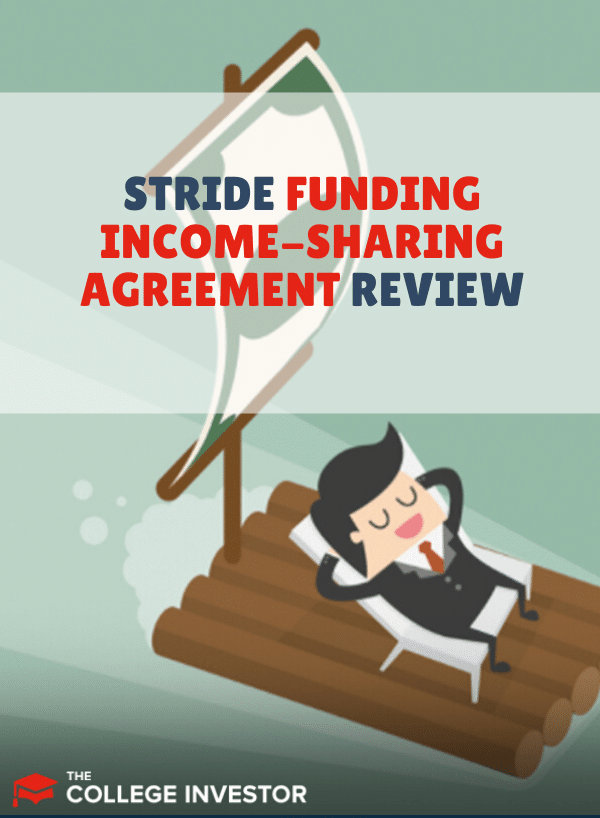
One of the most popular benefits of federal student loans is the ability to join an Income-Driven Repayment (IDR) plan. With private loans, on the other hand, your payments remain the same regardless of how much you earn.
But while IDR plans have made federal student loans overwhelmingly popular, what happens if you hit your annual or aggregate federal loans borrowing limit? Are there any borrowing options besides federal student loans that offer income-based repayment?
It turns out that the answer is yes. Income Share Agreements (ISAs), like the ones offered at Stride Funding, are alternatives to student loans. With an ISA, you commit a percentage of your income to repayment. If you're wondering whether an income share agreement could be right for you, keep reading our full Stride Funding review to learn more.
Stride Funding Details | |
|---|---|
Product Name | Stride Funding |
Min Borrowed Amount | $2,500 |
Max Borrowed Amount | $25,000 per year $50,000 aggregate maximum |
Repayment Period | 5 to 10 years |
Payment Cap | 2x borrowed amount |
Promotions | None |
What Is An Income Share Agreement?
An income share agreement is a funding option where a person agrees to repay a set percentage of their income in the future in exchange for money today. ISAs are a relatively uncommon way to fund an education, but they may make sense for people who are averse to taking out traditional debt.
Pros And Cons Of Income Share Agreements
Pros
Cons
Stride Funding ISA Terms and Benefits
ISAs are generally offered by schools. But Stride Funding is one of the few companies that offer income share arrangements regardless of the school that you attend. Since it is a unique form of financing, it’s important to understand some of the fine print associated with Stride Funding’s ISA.
Note: Stride Funding recently came under scrutiny for their lending model, with allegations that it could discriminate against minority students. See the full report here.
These are a few details to understand:
Eligibility
To qualify for a Stride Funding ISA, you'll need to be a US citizen attending a US school. Also, Stride ISAs are currently only being offered to the following students:
- Graduate students
- Undergraduate junior
- Undergraduate senior
Finally, you'll need to be enrolled at a 4-year college or university, or an accredited PA school, to qualify for a Stride Funding income share agreement.
Repayment Terms
Stride Funding offers income sharing arrangements that last from 5 to 10 years following graduation. The repayment period starts after a grace period of three months.
Salary Repayment Requirements
The percentage of income you repay depends on the amount you borrow. Each income share agreement is different, so Stride doesn’t provide strict guidelines. The percentage is based on your expected future income following graduation, but can be as low as 2%.
Higher expected earners (such as computer science engineers) are likely to see the lowest income share rate percentages. On the other hand, people expected to earn lower compensation (teachers, journalists, etc.) may be required to share a higher percentage of income.
Downside Protection
If you’re earning less than $30,000 per year ($2,500 per month), you don't have to make any payments whatsoever. That means you keep your money during your lower earning years, but you’ll repay Stride when you earn more.
Funding Limits and Repayment Cap
You can fund up to $25,000 per year of school through Stride Funding. Stride limits your repayment to twice what you fund. That means a person who borrows $25,000 will never repay more than $50,000, no matter how much she earns.
Are There Any Fees?
Stride doesn't charge any application or origination fees. You will be charged a $10 late fee though if you're more than 10 days late on a payment.
Stride says that it doesn't charge any prepayment penalties, but that's a bit misleading. If you try to pay off your loan early, you'll have to pay enough to hit your 2x payment cap.
Stride Funding expects that less than 5% of its borrowers will hit their payments caps if they made their monthly income-share payments as agreed. So, in a way, most borrowers would be penalized for paying off their agreements early.
How Does Stride Funding Compare?
Since Stride doesn't actually offer student loans, it can be difficult to compare them with other private lenders. But if you anticipate that it will take awhile for your income to ramp up after graduating, going with Stride could provide some much needed payment flexibility.
On the other hand, graduates who expect to have high starting salaries after leaving school, may be better off taking out a traditional student loan and paying it off as quickly as possible to minimize interest charges. Check out this quick comparison here:
Header |  | ||
|---|---|---|---|
Rating | |||
Min Borrowed Amount | $2,500 | $1,000 | $3,000 |
Income-Based Payments | Yes | No | No |
APR Type | N/A | Variable and Fixed | Fixed |
Cosigner? | Not Allowed | Allowed, Not Required | Not Allowed |
Cell |
How Do I Contact Stride?
You can get in touch with Stride by calling 214-775-9960 or emailing them at hello@stridefunding.com.
Note that Stride uses Knowledge Finance (a subsidiary of MOHELA) to service its loans. So if you questions about a bill or payment, that 's who you'll need to reach out to.
The toll free phone number for Knowledge Finance is 855-479-0490. Its customer service hours are 8 AM – 7 PM (CT), Monday – Thursday and 8 AM – 5 PM (CT) on Friday.
Why Should You Trust Us
I am America’s Student Loan Debt Expert™ and have been actively writing about and covering student loans since 2009. Myself and the team here at The College Investor have been actively tracking student loan providers since 2015 and have reviewed, tested, and followed almost every provider and lender in the space.
Furthermore, our compliance team reviews the rates and terms on these listing every weekday to ensure they are accurate. That way you can be sure you're looking at an accurate and up-to-date rate when you're comparison shopping.
Is Stride Funding Worth It?
If you've exhausted your federal student loan options, an ISA could be a better choice than private student loans. You get the benefit of income-based payments (which private loans can't match) while still having the guarantee that your repayment period won't last any longer than 10 years.
But is the ISA from Stride Funding a better deal than federal student loans? For undergraduate borrowers, probably not. If you're a graduate student, though, it could be worth comparing an ISA to Grad PLUS loans, which have the highest interest rates of all federal loans.
However, if you plan to go into public service (military, government, teaching, non-profit work, etc.) and may later qualify for PSLF, you'll definitely want to stick with federal loans, even if a Grad PLUS loan is your only federal loan option.
Stride Funding FAQs
Let's answer a few common questions about Stride Funding?
Are income-share agreements bad?
Whether an income-share agreement would be good or bad for you will depend largely on your goals. If you primarily want the assurance that your monthly payments will always be affordable, an ISA could be worth considering. But if paying the least overall is your top priority, you might be better off sticking with a traditional student loan.
Is Stride Funding legit?
Yes, while Stride has only been around since 2018, its leadership team is filled with experienced executives and it has raised $3.7 million in seed funding over three rounds.
Where is Stride Funding located?
Stride is headquartered in Dallas, TX and also has offices in Boston and Los Angeles.
Is getting approved for with Stride more difficult than getting a GradPLUS loan?
For most borrowers, no. Stride says that the approval process for its ISAs is very similar to GradPLUS Loans in that both funding options only require a minimal credit check and don't require cosigners.
Stride Funding Features
Min Borrowed Amount | $2,500 |
Max Borrowed Amount |
|
APR | N/A |
Repayment Period | 5 to 10 years |
In-School Deferment | Yes |
Origination Fee | No |
Prepayment Penalty | No, but borrowers will be required to pay enough to reach their payment cap. |
Late Fee | $10 |
Grace Period | 3 months |
Eligible Students |
|
Minimum Income Threshold | $30,000 |
Payment Cap | 2x times borrowed amount |
Cosigners Allowed | No |
Customer Service Phone Number | 214-775-9960 |
Customer Service Email | hello@stridefunding.com |
Loan Servicer | Knowledge Finance |
Loan Servicer Phone Number | 855-479-0490 |
Loan Servicer Customer Service Hours | Monday – Thursday, 8 AM – 7 PM (CT) Friday, 8 AM – 5 PM (CT) |
Address For Sending Payments | Knowledge Finance |
Promotions | None |
Stride Funding Review
-
Terms and Requirements
-
Repayment Costs
-
Customer Service
-
Ease of Use
-
Rewards and Perks
Overall
Summary
Stride Funding’s income-share agreements are alternatives to student loans. They offer income-based payments and don’t require cosigners.
Pros
- $30k minimum income threshold
- Borrow without a cosigner
- Never pay more than two times your original borrowed amount
Cons
- May cost more overall than traditional student loans
- No benefit to early payoff of your ISA

Robert Farrington is America’s Millennial Money Expert® and America’s Student Loan Debt Expert™, and the founder of The College Investor, a personal finance site dedicated to helping millennials escape student loan debt to start investing and building wealth for the future. You can learn more about him on the About Page or on his personal site RobertFarrington.com.
He regularly writes about investing, student loan debt, and general personal finance topics geared toward anyone wanting to earn more, get out of debt, and start building wealth for the future.
He has been quoted in major publications, including the New York Times, Wall Street Journal, Washington Post, ABC, NBC, Today, and more. He is also a regular contributor to Forbes.
Editor: Clint Proctor Reviewed by: Ashley Barnett

